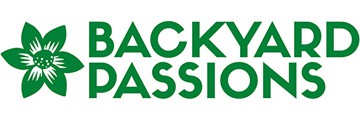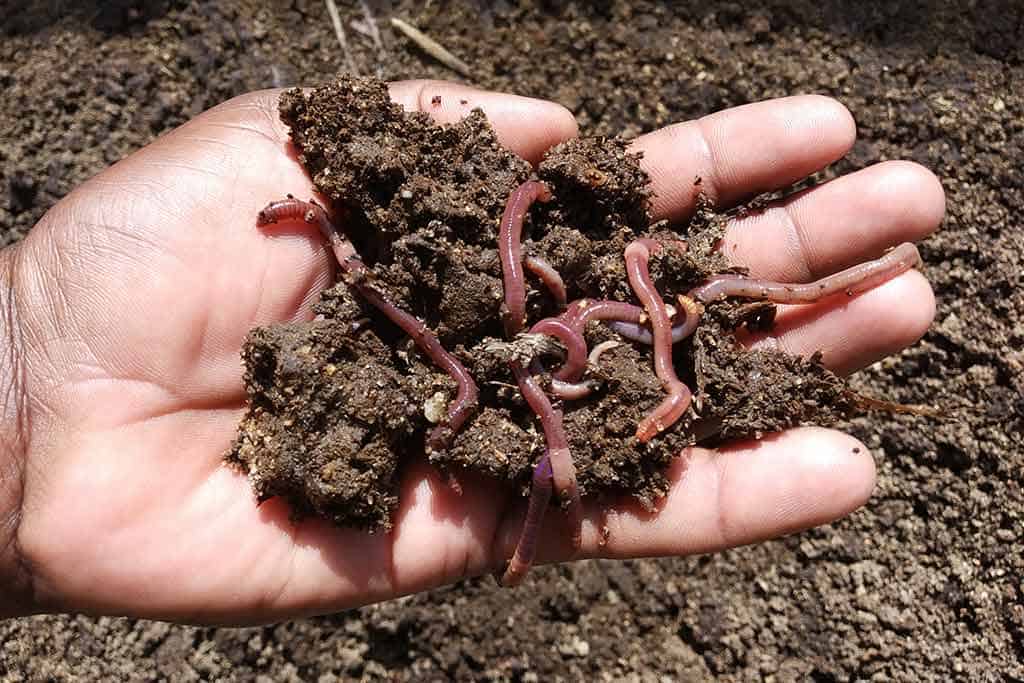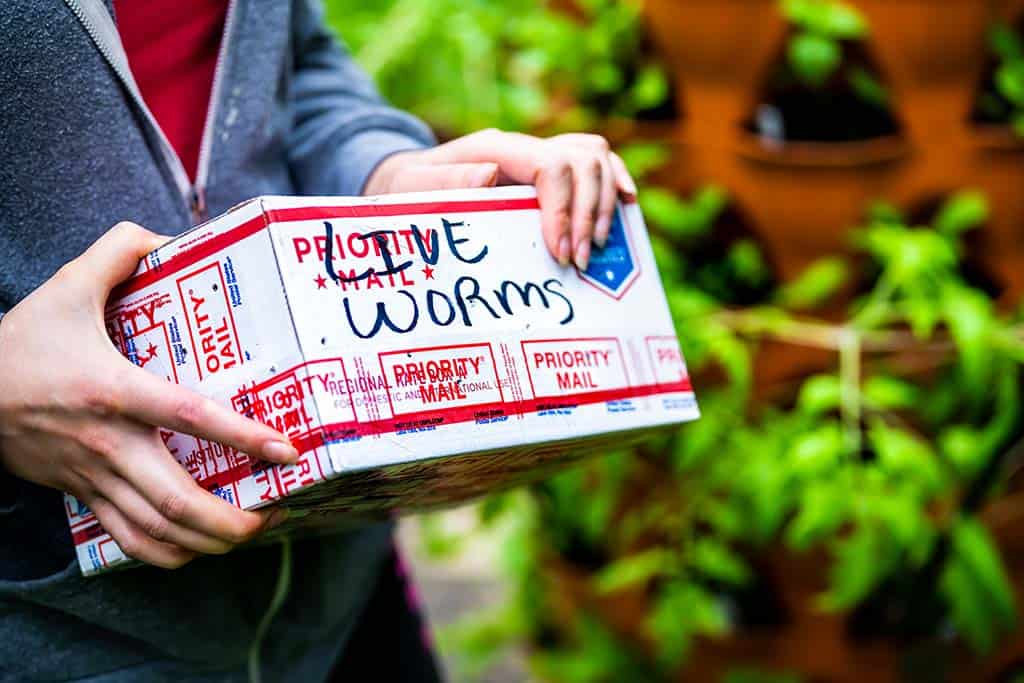Worm composting is a wonderful way to help dispose of your home’s organic waste while helping the environment by limiting your waste that goes into landfills. You should have enough food and organic waste to keep a bin of composting worms with all the food they need to live a full life cycle. The benefit for you is that your flower beds and potted plants will be improved by the addition of the vermicompost that’s produced by the worms.
Vermicompost is a dark, rich soil-like substance that is a perfect plant growth medium used in gardening. It’s also a valuable gardening product. If you have ever looked at purchasing organic vermicompost, you’ll know it’s not cheap to buy. So, why bother spending money to buy bags of vermicompost when you can make it at home for free. Just feed organic waste to your worms, and they will repay you by converting waste into nutrient-rich vermicompost.
What Do You Need When Making a Worm Compost Bin?
To create your worm compost bin, you will need a few things to get you started.
Bin or Containers – First, you’ll need a bin or container in which to house your worms. There are many commercially available worm composting bins that you can purchase. Many are of the stacking-tray type, but there are other varieties too. They can be made from a wide range of materials, although plastic is probably the most common. The bin you will want to choose will partly be determined by whether you’ll be keeping it indoors or outdoors. If you cannot find the bin you want, the internet is full of plans to build and create your own. However, you could easily start worm composting in a large bucket or even a plastic storage box.
- Newspaper – A few sheets of newspaper are useful to have in a bin.
- Bedding Material – Next, you will need some bedding material for the worms. You can use leaves, straw, shredded newspaper, and egg cartons. But a popular type of bedding that is used by many worm bin owners is coconut coir.
- Hessian sack cloth – You’ll need this to use as a cover for the worm bedding to help keep moisture in and pests out.
- Eggshells – Crush up eggshells until you have a good handful.
- Garden Soil – Finally, you need about one liter of soil. This can be regular soil from your backyard or even soil purchased from a garden center. The soil not only provides a little grip, so the worms can easily crawl through the bedding material but also inoculates the bedding with the microorganisms needed to decompose the food you add to the bin.
How Do You Start Worm Composting?
- Line the bottom of the tray or bin – Starting a worm composting bin is simple. If you’re using a commercially available worm bin the first thing you need to do is line the tray with a couple of sheets of newspaper. Although the newspaper will help absorb a little excess moisture, it will prevent some of the fine particles of the new bedding material from falling through the holes in the bottom of the tray.
- Prepare the bedding – If you’re just starting out with worm composting, the best bedding to use is coconut coir fiber. You can buy this online in the form of a brick. Soak a coconut coir brick in 2 or 3 liters of water and leave for around 30 minutes. The brick will completely absorb the water and expand to many times its original volume. It will feel a little like a moist sponge and have the loose texture of compost. If it is too wet, you can squeeze out some water using your hands. This is a key step since if the bedding is too wet, the worms will have difficulty absorbing oxygen and will respond by trying to climb out of the bin.
- Add crushed eggshell and soil – Add the crushed eggshells and soil into the bedding. then mix everything together. You don’t have to be completely thorough until everything has been perfectly mixed together, just ensure you’ve done a reasonable job of mixing.
- Add the worms – When you have this done, you can simply add the worms. The worms should be placed on top of the bedding, along with any bedding that they came in. They can then tunnel and dig their way into the new bedding and out of the light. The worms will also eat the bedding and poop it out as worm casts.
- Cover the bedding and close the worm bin – The next step is to lay the hessian sackcloth over the top of the bedding and worms and fit the worm bin lid or cover. Now set the worm bin aside for a few days or even a week.
- Wait a few days before starting to feed – After a few days, you can start feeding your worms the organic waste from your kitchen or yard. To feed the worms, start at one side of the bin and pull back some bedding material to make a 4-inch-wide trench. Then place a handful of food scraps in the trench and cover with the bedding. Finally, replace the hessian blanket and worm bin lid.
- Repeat feeding weekly – If after a week all the food scraps have gone you can feed your worms some more food scraps. When adding more food, make a trench next to the previous one, add a handful of scraps, and cover with bedding. When you eventually get to the end of the bin, return to the side where you originally began feeding the worms and start again.
How Many Worms Do You Need to Start Composting?
When starting out with worm composting, it is important to know how many worms you need to buy for your wormery. If you have too many worms for the quantity of kitchen and gardening scraps you have available, your worms will starve, and you won’t get a crop of vermicompost. Of course, if you have too few worms for the food scraps you have, they won’t be able to eat through everything. The leftovers may become sour, create a wet environment, and start to smell. A situation that neither you nor your worms will appreciate. Again, the result will be little or no vermicompost.
Another factor to consider is the size of your composting bin. As a rough guide, you should aim at a population density of about 1,000 worms per square foot. So, taking the Worm Factory basic 3 tray worm composter on Amazon as an example. Each tray is a 16″x16″ square, so the area is a little under 2sq ft. Therefore, each tray could happily accommodate around 2,000 worms. Even so, it’s probably best to start off with about 1,000 worms, which weigh about 1lb. You could begin with half or even a quarter of that number, but you’ll need to be careful not to overfeed the worms until they get established.
But getting back to the quantity of food scraps you produce daily, it’s no good guessing. Nor do you want to base an estimate on just a single day, since the daily amount can vary. Instead, for a week collect all your food scraps in a bucket, the weigh the contents. By dividing the total weight by seven you’ll have an idea of the average amount of food waste you generate daily. Armed with that knowledge, you can estimate the number of worms you’ll need.
On average, worms can eat half their body weight in food each day. So, if your daily food scraps amount to about one pound, then you’ll need two pounds of worms, which is approximately 2,000 worms.
Where can I get composting worms?
Don’t be tempted to go digging for worms in your yard. For a start, earthworms are the wrong kind of worm for your worm bin or worm factory. You need worms that live near the surface and concentrate beneath fresh organic material that has accumulated at ground level. In a tidy backyard, it’s unlikely that you’ll find enough composting worms, like Red Wigglers or European Night Crawlers.
Nor would I advise going into a forest and foraging for red worms under fallen trees and leaf litter. It’s not an environmentally friendly practice, especially if everyone started doing the same. It may even be illegal, depending on your location.
Instead, look for a local supplier or buy your worms online. At least you’ll know you are getting the correct type of worm and not having a negative effect on the environment. You can find plenty of composting worms available on Amazon, and they won’t come to any harm when shipped in the mail.
What Can You Feed Composting Worms?
You can feed your worms most types of organic material, although there are some that are best avoided or only given in small quantities.
Things you can feed your composting worms include:
⦁ Coffee grounds and filters
⦁ Eggshells (crushed)
⦁ Fruit scraps
⦁ Teabags
⦁ Vegetable scraps
⦁ Table scraps (not containing dairy, oils, or meat)
However, you should avoid feeding the following to your worms:
This list of foods not to feed your worms includes things that they dislike, could cause bad smells, might create an environmental imbalance in the worm bin, or attract vermin. So, either avoid or only add very small amounts of the following scraps.
⦁ Bread
⦁ Citrus
⦁ Dairy products
⦁ Fatty foods
⦁ Fish and meat scraps
⦁ Garlic
⦁ Onions
⦁ Potato skins (uncooked)
How Long Does It Take to Compost with Worms?
Depending on how much you feed your worms and how many worms you have, the vermicompost could be ready to harvest in 3 to 6 months.
This means that you can harvest vermicompost 2 to 4 times each year.
Many people make the mistake of trying to harvest their vermicompost too soon. This can cause you to lose some of your worm population. So, only harvest vermicompost when you are sure that it is ready, and you have migrated the worms out of the finished vermicompost.
How Much Compost Can Worms Make?
Composting worms, such as Red Wigglers, can produce about one-third of a pound of worm castings per day or ten pounds of worm castings per month. The castings, also known as vermicompost, can be added back into your soil as a nutrient-rich fertilizer or used to make a liquid fertilizer called worm tea.
Worm tea is a liquid fertilizer derived from worm castings. When worm castings are soaked in water overnight, they provide a natural liquid fertilizer that is packed with nutrients and useful microbes. These nutrients and microbes can help promote healthy plant growth.
Although a pound of worms may consume approximately 1/2lb of food per day, that does not mean it will all be converted into worm castings. Food is about 70% water whereas the water content of worm castings is about 20%. Plus, some of the food will be used by the worms for growth, reproduction, and metabolism. So, it is realistic to expect less finished compost than the weight of food put into the worm bin.
However, under ideal conditions, you could increase the amount of vermicompost produced each day. For instance, if the moisture and temperature levels are perfect, or if the food is already partly composted, such as horse or cow manure. You could then expect around 15lbs of castings per month from a pound of Red Wigglers.
Conclusion
You can see it’s not difficult to get started with worm composting, and it doesn’t need to cost much either. Although you can buy commercially available worm bins or factories you could adapt a plastic container that you already have. It just needs to be large enough to accommodate the number of worms you need to deal with your food waste. As a reminder, 1,000 worms weigh about 1lb and will eat half their weight in food each day. Each month they will produce about 10lbs of worm casts, or vermicompost, that you can use in your gardening.



